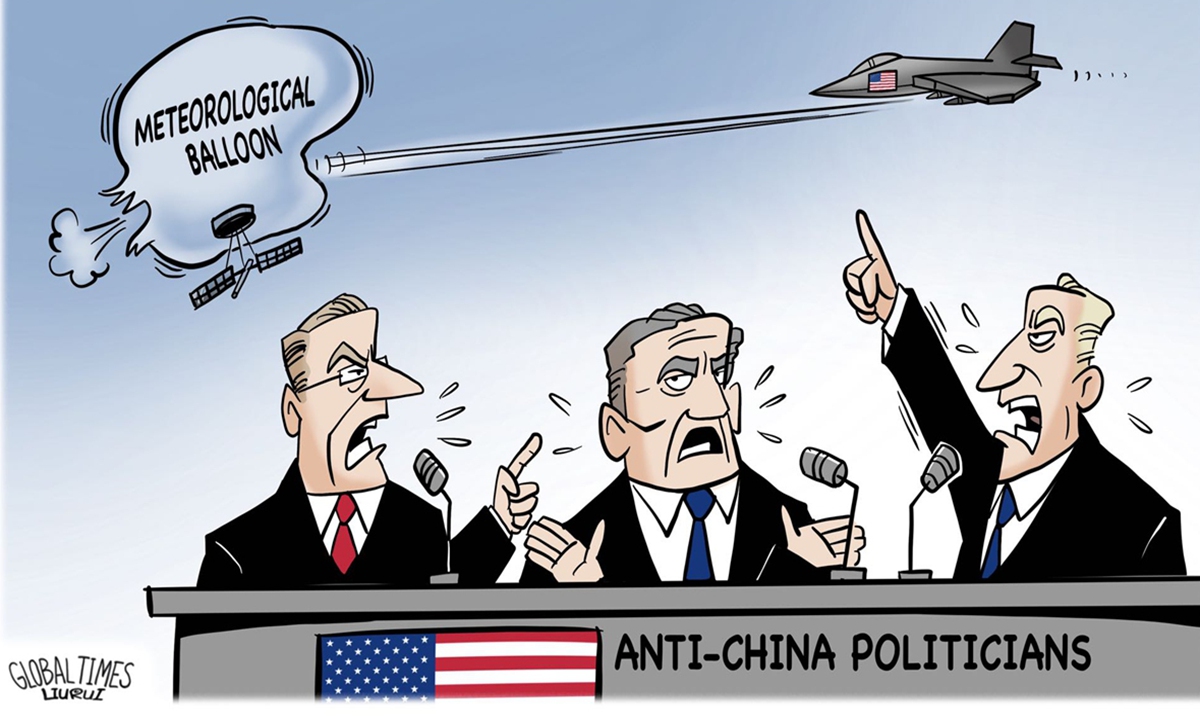
Illustration: Liu Rui/GT
If you want to make a prediction on the trajectory of Washington's policy toward China, the Chinese balloon that recently floated to the US is a good "test."
The meteorological research balloon's sudden appearance over the US at a time of ongoing tension and uncertainty in US-China relations has triggered a variety of reactions from the US side, from the White House to Congress, from the media to the public. The information revealed therein can be gathered together to give a more realistic assessment of the air pressure, temperature, and weather conditions of the US policy toward China.
This "test" is not intentional on behalf of any party, but it is precisely this unexpectedness that makes the results of this test even more accurate.
After Biden took over the White House, US-China relations have shown an even sharper downhill trend. Although the US side has shown interest in increasing communication and strengthening management so far this year, it has remained largely verbal.
In terms of curbing high-tech exports to China and strengthening military deployments around China, Washington is still moving forward with its so-called competition strategy with China step-by-step, and uncertainty in the bilateral relationship is increasing.
The prevailing concern is whether the future US-China relationship can maintain a manageable operation in an extreme climate and under possible high-pressure shocks.
At this juncture in time, the balloon incident happened unexpectedly.
The US' response on three levels reveals the potential for continued deterioration but also the possibility of stability at the present level in the US-China relationship.
The first level is that of radical congressional and military figures who hold strong hostile sentiment toward China. They have deliberately exaggerated the incident and "manufactured" it as further evidence of a Chinese military threat. Some have given full play to the imagination of China as an enemy, making it appear that China's military capabilities are fully surpassing those of the US and could win a future war with the US.
The US media, as a second level, quickly "amplified" the story into a global media headline. While there was some objective reporting, most media outlets used it to play up China's hostility toward the US. Some media outlets also rehashed old historical accounts, retelling the story of Japan's World War II high-altitude balloon bombs.
In May 1945, a bomb hanging from a tree in Kansas exploded, killing six people. This was the only civilian casualty on US soil during World War II. An investigation afterward proved that the bomb was delivered to the US by a Japanese-made balloon.
However, an American friend told me that most Americans are not as rich in their ability to make associations, and they see the incident more as news for after-dinner gossip. In this regard, the people of the two countries mainly have the same opinions. Chinese people are also more concerned about the drama of the incident. Jokes went viral in WeChat groups, not some fearful sentiment that China and the US are going to fight against each other.
Some people made jokes saying that it was because the US curbed the export of high-end chips to China, and Chinese balloons lacked chips, were not precise enough, and lost their way, so it "wandered".
In fact, the ordinary people on both sides have a better understanding of the relationship between the two countries than some politicians, experts, or military personnel, and the balloon incident and the reactions it has triggered since then have not, by and large, exceeded the framework of their perception of the current state of bilateral relations.
After all, balloons used for weather research are not strategic weapons, and the reality of US-China relations has not reached the level of US-Soviet tensions during the Cold War. At that time, both the US and the Soviet Union had used air defense systems to shoot down thousands of each other's balloons.
A further look at the White House's several statements on the incident still seems to indicate that Washington exercised some restraint. In fact, both the US and China have exercised considerable restraint at the government level, and both are interested in not allowing the balloon incident to trigger an escalation in the deterioration of relations. This is probably the most important point of this test.
Washington's performance in this case is more of a "political show" and while it will not quickly reverse its strategic course of continuing to compete with China, it is still willing to manage its differences through coordination to prevent direct "military conflict." The next challenge is whether the US-China relationship will enter a phase of relative stability, and to some extent, how much the White House can control or coordinate with the Congress, to avoid the disruptions.
The author is a senior editor with People's Daily, and currently a senior fellow with the Chongyang Institute for Financial Studies at Renmin University of China. dinggang@globaltimes.com.cn. Follow him on Twitter @dinggangchina




